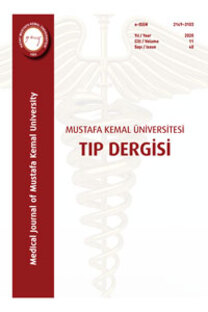KLARİTROMİSİNE BAĞLI GELİŞEN AKUT PANKREATİT
Akut pankreatit vakalarının çoğu safra yolu hastalıkları ve alkol kullanımı nedeniyle gelişir. Akut pankreatite yol açabilecek diğer faktörler abdominal travma, endoskopik retrograd kolanjiyo pankreatografi, hiperparatiroidi, hiperlipidemi, viral enfeksiyonlar ve ilaçları içerir. Akut pankreatitlerin %2’sinin ilaçlarla ilişkili olduğu düşünülmektedir. Otuz üç yaşında erkek hasta peptik ülser nedeniyle kendisine başlanmış olan klaritromisin, amoksisilin ve lansoprazol tedavisinin üçüncü günü kliniğimize pankreatit bulgularıyla başvurdu. Hastada klaritromisin kullanımı dışında pankreatit nedeni olabilecek herhangi bir ilaç kullanımı bulunmamaktaydı. Literatürde makrolid grubu antibiyotik kullanımına bağlı olarak geliştiği bildirilmiş olan birkaç akut pankreatit olgusu mevcuttur. Bu makalede de klaritromisin kullanımı sonrası gelişen akut pankreatitli bir olgu sunulmak istenmiştir.
Anahtar Kelimeler:
Klaritromisin, akut pankreatit, makrolid
KLARİTROMİSİNE BAĞLI GELİŞEN AKUT PANKREATİT
Most cases of acute pancreatitis develop due to biliary tract diseases or alcohol intake. Other factors of may lead to acute pancreatitis include abdominal trauma, endoscopic retrograde cholangio pancreatography, hyperparathyroidism, hyperlipideamia, viral infections and drugs. It is estimated that 2% of cases of acute pancreatitis are related to drugs. A 33 year-old male patient who had peptic ulcer was receiving claritromicin, amoxicillin and lansoprazole admitted to the hospital with acute pancreatitis symptoms in the third day of his treatment. Except for the usage of clarithromycin, the patient did not take any other drugs and there was no other obvious cause for his acute pancreatitis. There were a few reports of acute pancreatitis associatedwith other macrolide antibiotics in the literature. In this article, we present a case of acute pancreatitis after a course of clarithromycin.
Keywords:
Clarithromycin, acute pancreatitis, macrolid,
___
- 1. Friedman LS, Liver, biliary tract & pancreas disorders. In: McPhee SJ, Papadakis MA. Lange Current Medical Diagnosis & Treatment. New york, Mc Graw Hill, 2013;662- 717.
- 2. Wilmink T, Frick TW. Drug-induced pancreatitis. Drug Safety 1996;14:406. 3. Battillocchi B, Diana M, Dandolo R et al. Drug-induced acute pancreatitis: a personal contribution. Chir Ital. 2002;54(5):605-612.
- 4. Gumaste VV. Erythromycin-induced pancreatitis. Am J Med. 1989;86:725. 5. Trimble GX. Acute pancreatitis induced by erythromycin. Am J Med. 1989; 87(6):701.
- 6. Hawksworth CR. Acute pancreatitis associated with infusion of erythromycin lactobionate. Br Med J. 1989;298:190.
- 7. Fang CC, Wang HP, L in JT. Erythromycin-induced acute pancreatitis. J Toxicol Clin Toxicol. 1996;34(1):93-95.
- 8. Berger TM, Cook WJ, O’Marcaigh AS, et al. Acute pancreatitis in a 12-year-old girl after an erythromycin overdose. Pediatrics. 1992;90(4):624-626.
- 9. Renkes P, Petitpain N, Cosserat F, Bangratz S, Trechot P. Can roxithromycin and betamethasone induce acute pancreatitis? A case report. JOP. 2003; 4(5):184-186.
- 10. Souweine B, Fialip J, Ruivard M, Aumaitre O, L avarenne J, Phillipe P. Acute pancreatitis associated with roxithromycin therapy. DICP. 1991;25(10):1137.
- 11. Leviu L, Yair L, Yehuda S. Pancreatitis induced by clarithromycin. Ann Intern Med. 1996;125(8):701.
- 12. Rassiat E, Michiels C, Jouve JL, Sgro C, Faivre J, Hillon P. Acute pancreatitis after clarithromycin and beta-methasone. Gastrenterol Clin Biol. 2003;27(1):123
- 13. Shouwenberg BJ, Deinum J. Acute pancreatitis after a course of clarithromycin. Neth J Med. 2003;61:266.
- 14. Bradley EL 3rd. A clinically based classification system for acute pancreatitis. Summary of the International Symposium on Acute Pancreatitis, Atlanta, Ga, September 11 through 13, 1992.Arch Surg. 1993;128(5):586-590.
- 15. Carroll JK, Herrick B, Gipson T, Lee SP. Acute pancreatitis: diagnosis, prognosis, and treatment. Am Fam Physician. 2007;75(10):1513-1520.
- 16. Underwood TW, Frye B. Drug-induced pancreatitis. Clin Pharm. 1993;12(6):440-448.
- 17. Runzi M, L ayer P. Drug-associated pancreatitis: facts and fiction. Pancreas. 1996;13(1):100-109.
- ISSN: 2149-3103
- Yayın Aralığı: Yılda 3 Sayı
- Başlangıç: 2010
- Yayıncı: Hatay Mustafa Kemal Üniversitesi Tıp Fakültesi Dekanlığı
Sayıdaki Diğer Makaleler
Füsun AYDOĞAN, Erhan YENGİL, Nilgül ÜSTÜN, Raif ÖZDEN, Mehmet HELVACI
Mustafa Özgür, Celalettin Dağlı, Fatma Ceylan, Harun Atıcı, Murat Karcıoğlu
KLARİTROMİSİNE BAĞLI GELİŞEN AKUT PANKREATİT
M. ÇELİK, Mehmet DEMİR, Melda BULGURCU, Ali KARAKUŞ, Gamze KAVVASOĞLU
GEÇİCİ HEMODİYALİZ KATETER UYGULAMALARIMIZ
Ümit Halıcı, Mehmet Kayğın, Özgür Dağ, Hüsnü Limandal, Ümit Arslan, Adem Kıymaz, Ahmet Aydın, Bilgehan Erkut
ENSEFALOMALAZİK GÖRÜNÜMLÜ GLİABLASTOME MULTİFORME: OLGU SUNUMU
S. BAŞARSLAN, Cüneyt GÖÇMEZ, Abdülkerim GÖKOĞLU, Ahmet MENKÜ
